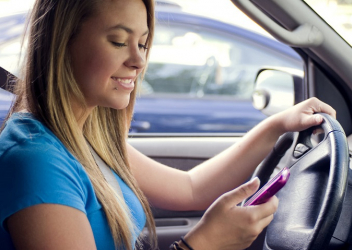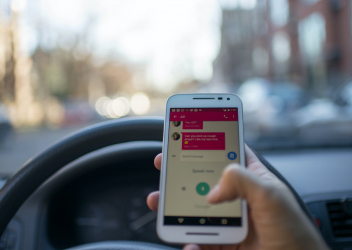Distracted Driving Research
Cell phones and passengers are a major source of inattention to the roadway and are a contributing factor in motor vehicle crashes involving teens behind the wheel. Engaging in handheld cell phone use increases the risk of a crash substantially, and distracted driving research is much needed to prevent crashes involving young drivers. Investigators at the Penn Injury Science Center and the Annenberg Public Policy Center collaborated with CIRP researchers to develop behavior change interventions that include strategies to encourage focused attention on driving.
These studies tested different interventions aimed at reducing distracted driving, particularly in teen drivers, including a web-based educational intervention and behavioral economics strategies, as well as different ways to implement technological solutions, such as automated blocking of cell phone use and silencing of notifications while the vehicle is in motion. Outcomes for these studies are measured either through use of a driving simulator and/or a smartphone application and paired in-vehicle device.
For current research being conducted at the Penn Injury Science Center, click here.
Research Projects
- Implementation of Technology That Limits Handheld Cell Phone Use While Driving
Novel smartphone applications exist that can limit handheld cell phone use while the vehicle is in motion by locking the phone screen, silencing notifications, and sending automated responses to incoming text messages. These applications work by detecting when the vehicle is traveling over a certain speed threshold. In some cases, hands-free use of navigation and music apps may be permitted if programmed at the beginning of the drive or while stopped. We are testing different ways to implement this technology to sustainably reduce cell phone use distraction in the long run. Ongoing pilot studies of distracted driving research include:
Way to Safety 3.0: The Teen-Parent Study
Teen drivers often tell researchers their parents urge them not to text while driving because it is dangerous, yet the teens frequently see them checking email or texting while driving. In this study, researchers are using a smartphone application that tracks and limits cell phone use while driving. Parents are notified via email when their teen overrides the cell phone blocking function. The study tests the feasibility of an intervention in which teens also receive an email alert when their parents override the cell phone blocking function. The overall goal of the research is to reduce rates of cell phone use while driving for the entire family.
Way to Safety 2.0: Opt-in vs. Opt-out Cellphone Blocking +/-Notifications
This study tests the feasibility of different cell phone blocking strategies among teen drivers. The first is “opt-in” blocking, which is similar to using “Airplane Mode:” Drivers must remember to turn on the app when getting in the car. The second is “opt-out” blocking: The app activates automatically when the vehicle is in motion. The third strategy is “opt-out” blocking with notifications: This is the same as the second strategy, but parents will also be alerted when the teen overrides the blocking strategy.
Distracted Driving App Study
This study examines the effectiveness of a distracted driving smartphone application for teen drivers and their parents. The app activates automatically when the vehicle is in motion, uses innovative recognition software to determine if the phone-user is the passenger or driver of the vehicle, and locks the phone while the user is driving.
- Attitudes on Technological, Social, and Behavioral Economic Strategies to Reduce Cell Phone Use While Driving in Teens
The majority of U.S. teens admit to handheld cell phone use while driving, an increasingly common cause of crashes. Attitudes towards novel cell phone applications and settings that block use while driving are poorly understood, potentially limiting their use. The researchers examined teens' willingness to reduce cell phone use while driving and perceptions of potential strategies to limit this behavior via a survey.
Read the study abstract
Read the press release
- Feasibility Testing of an Intervention to Reduce Teen Driver Inattention
This program of research uses a web-based intervention based on the Theory of Planned Behavior that aims to reduce distracted driving and teen driver inattention to the roadway. Researchers developed the intervention from elicitation and survey data from previous work and empirical evidence in the literature. The results of this formative research on cell phones and peer passengers were published in Traffic Injury Prevention, the Journal of Pediatric Nursing, and the Journal of School Nursing. They then pilot tested the intervention using driving simulation to test the effects of the intervention on cell phone use, passenger engagement, and driving performance.
Read a blog post about the research
Listen to a podcast about the research
- Novel Smartphone-Based Measures of Adolescent Cell Phone Use While Driving
This study examined novel measures of cell phone use while driving to better understand how and at what speeds adolescents use their cell phones while driving. The researchers enrolled a small group of adolescent drivers who were licensed for less than 90 days to install a device in their vehicle and an application on their smartphone to see if the study team could measure interaction with the cell phone. The researchers were able to collect data on how often the young drivers “unlocked” their cell phone, their trip length in miles and hours, and vehicle speed. Results showed engagement at high speeds, which is particularly risky for newly licensed drivers. The information gathered about how adolescent drivers engage with their phones at elevated speeds will help inform future research on the nature of risky driving behaviors and how to prevent them.
Read the study abstract
Read a blog post about the research
- Using Behavioral Economics Strategies to Curb Cell Phone Use While Driving
This study, funded by the Federal Highway Administration, will investigate behavioral economics strategies to reduce cell phone use behind the wheel. Behavioral economics combines insights and findings from psychology and economics to explain, and try to correct, counter-productive or predictably irrational decision-making. These strategies have been found to be successful in helping people change difficult health behaviors, such as smoking and not taking medications as prescribed.
The study team hopes to develop interventions that can be delivered through smartphones to discourage cell phone use while driving, a dangerous distraction. The researchers will investigate strategies that can be deployed in usage-based insurance (UBI) programs using data collected by Progressive Insurance based on an app developed by TrueMotion, a smartphone telematics platform.
Read a press release about the study grant.
Principal Investigators: Kit Delgado, MD; Catherine C. McDonald, PhD, RN, FAAN
Funding: Institute for Translational Medicine and Therapeutics/Center for Health Incentives and Behavioral Economics Pilot Grants Program; University of Pennsylvania NIA Roybal Center for Behavioral Economics; National Institute of Child Health and Human Development; National Heart, Lung, and Blood Institute; National Institute of Nursing Research; the University Research Foundation at PENN; the Dr. Dorothy Mereness Endowed Research Fund at the University of Pennsylvania School of Nursing; the Federal Highway Administration.
- Opportunities to Reduce Distracted Driving and Adolescent Driver Motor Vehicle Crashes
This commentary about the Flaherty et al study, both published in the May 2020 issue of Pediatrics, agrees that the lower incidence of fatal crashes for 16- to 19-year-old drivers in states with primarily enforced texting bans is encouraging since previous research examining the association between cell phone bans and lower rates of fatal crashes in teen drivers showed mixed results. However, no one strategy will prevent cell phone use while driving in adolescents. It will take a multipronged approach, one that addresses the unique factors that contribute to distracted driving in teens behind the wheel.
Read the commentary
Read a HealthDay article about the research
Authors: Catherine C. McDonald, PhD, RN, FAAN; Kit Delgado, MD; Mark R. Zonfrillo, MD
Funding: National Institute of Child Health and Human Development
- Rethinking Cell Phone Use While Driving: Isolated Risk Behavior or a Pattern of Risk-Taking Associated with Impulsivity in Young Drivers?
This study, conducted by researchers at Children's Hospital of Philadelphia and the Annenberg Public Policy Center at the University of Pennsylvania, revealed that young adults who use cell phones while driving also engage in other risky driving behaviors, including speeding, running red lights, and impatiently passing a car in front on the right. Published in the Journal of Environmental Research and Public Health, the research found that this pattern of risk-taking is associated with impulsivity and the authors stress the importance of developing new strategies to prevent risky driving in young adults, ones that promote save driving behaviors more broadly.
Read the study abstract
Read the press release
Principal Investigators: Elizabeth Walshe, PhD; Dan Romer, PhD; Flaura Winston, MD, PhD
Funding: Annenberg Public Policy Center at the University of Pennsylvania; Center for Injury Research and Prevention at Children's Hospital of Philadelphia















